1 The Civil Rights Movement We have talked

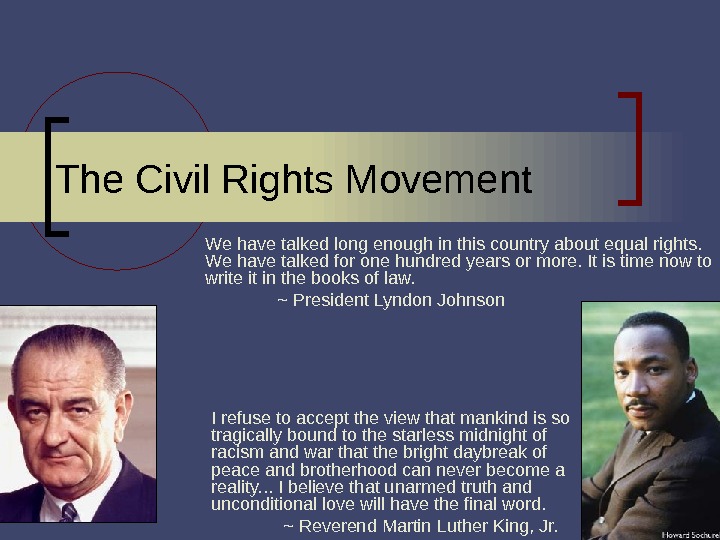
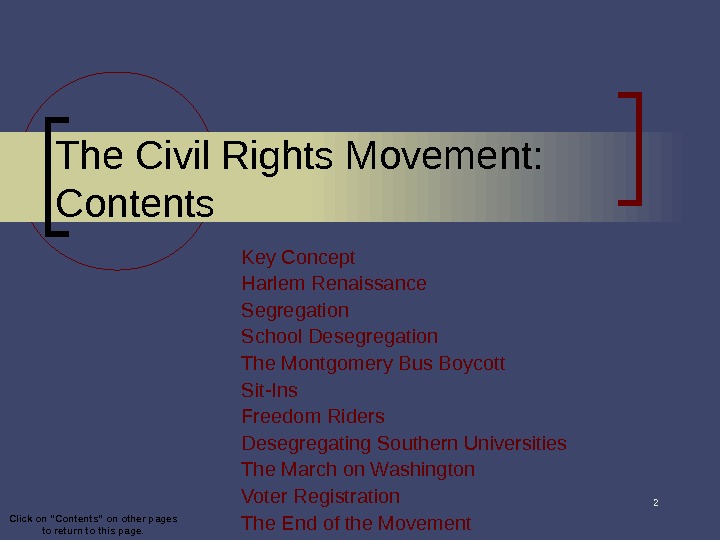
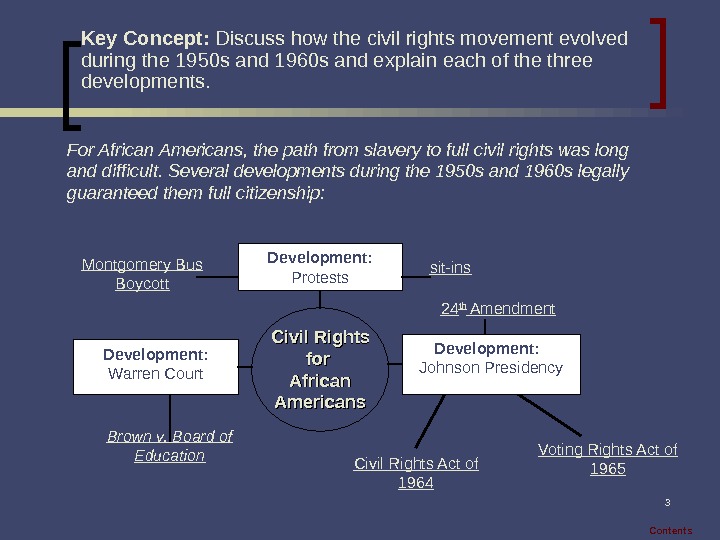
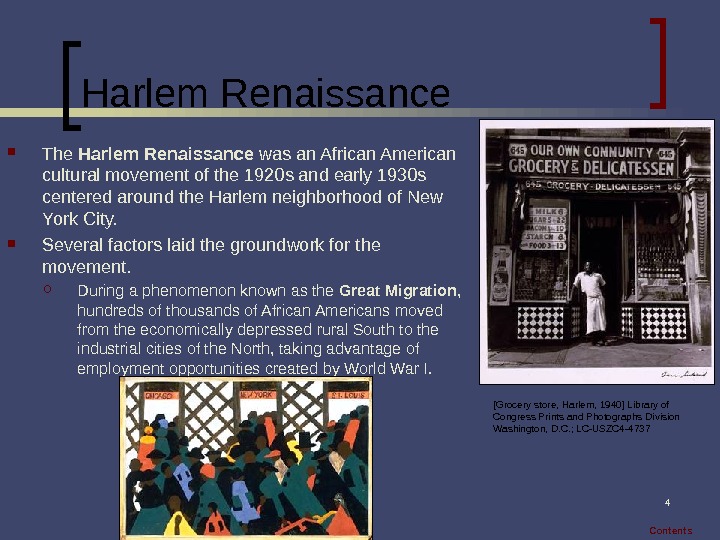
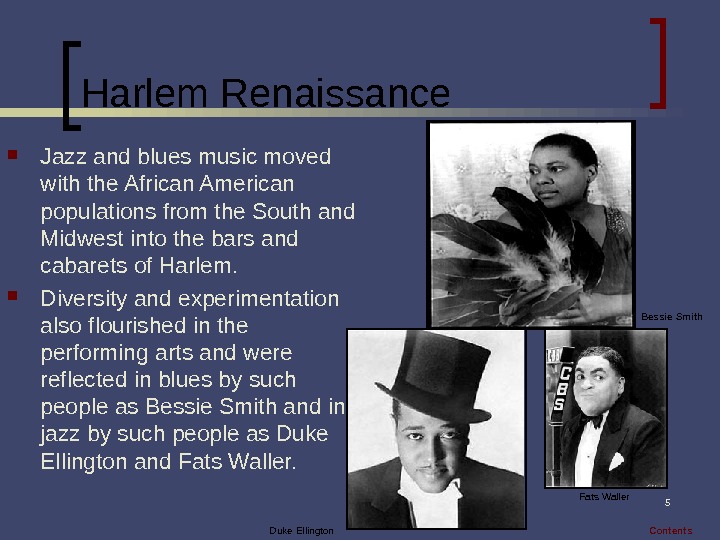
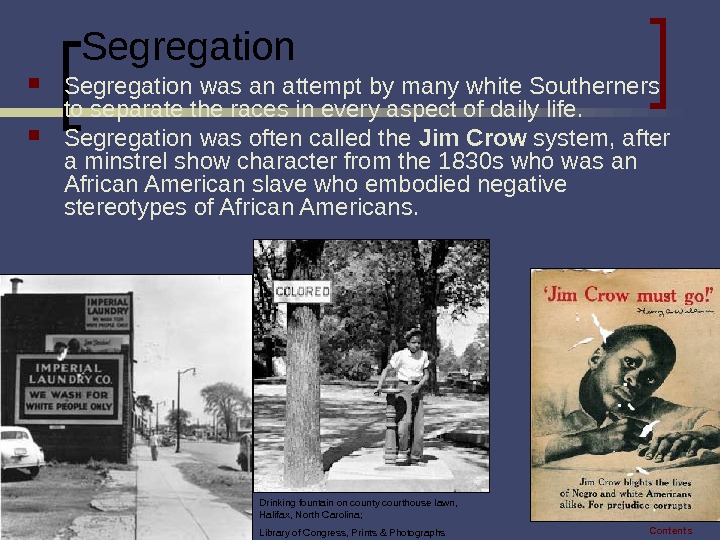
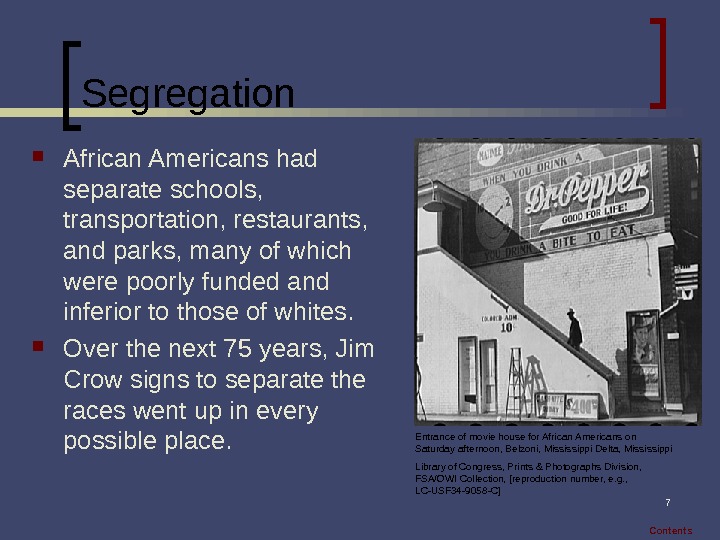
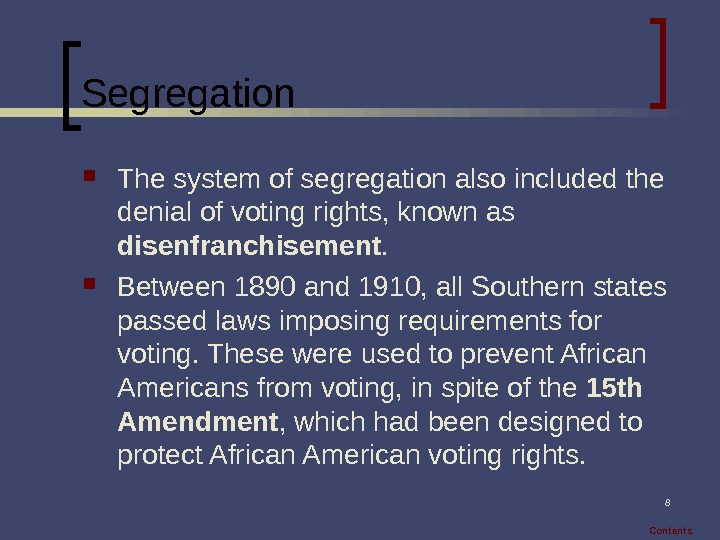
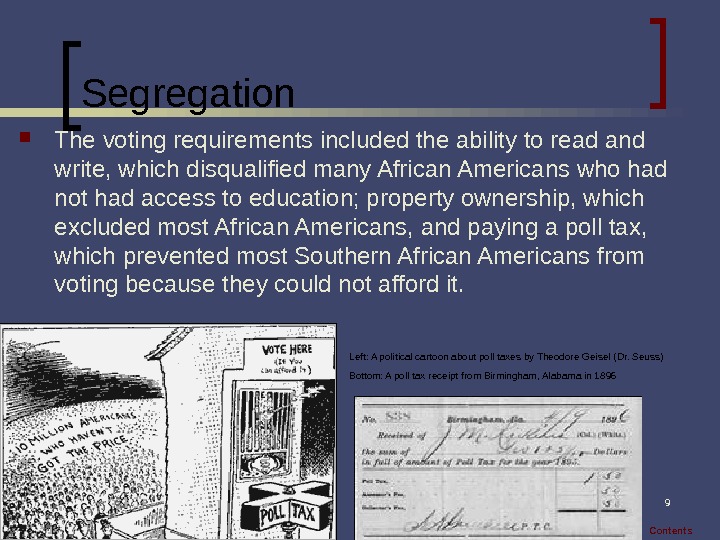
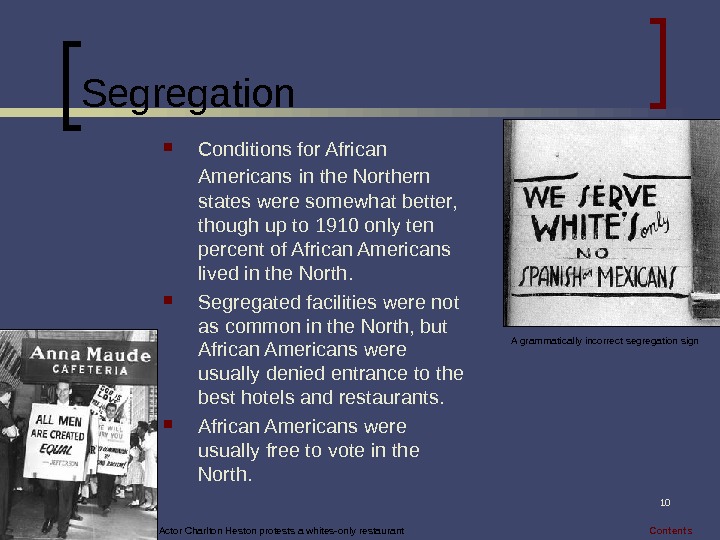

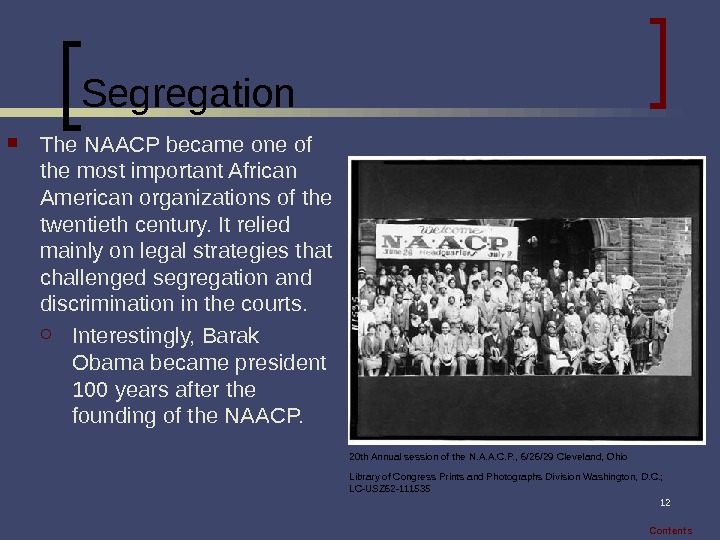
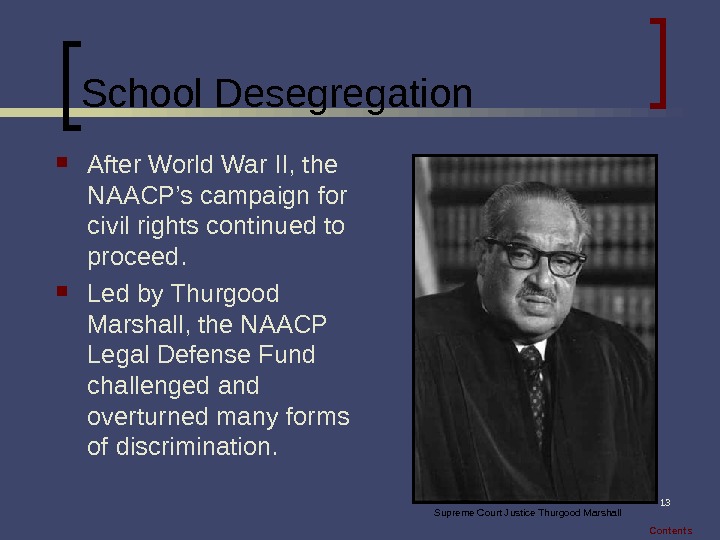
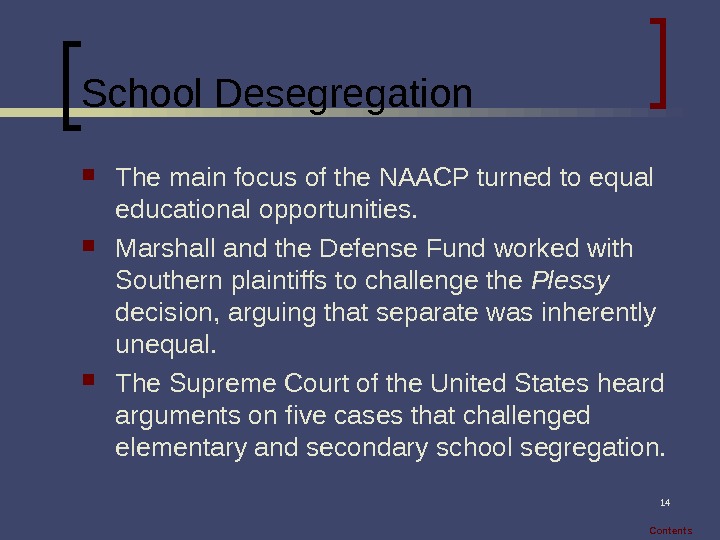
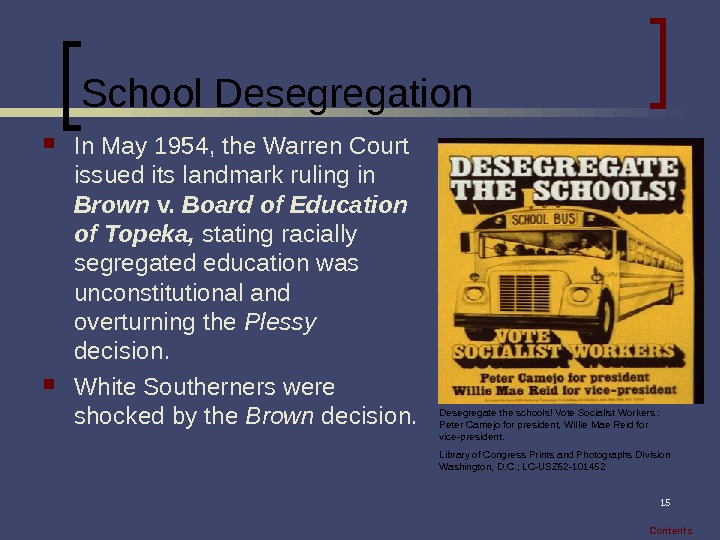
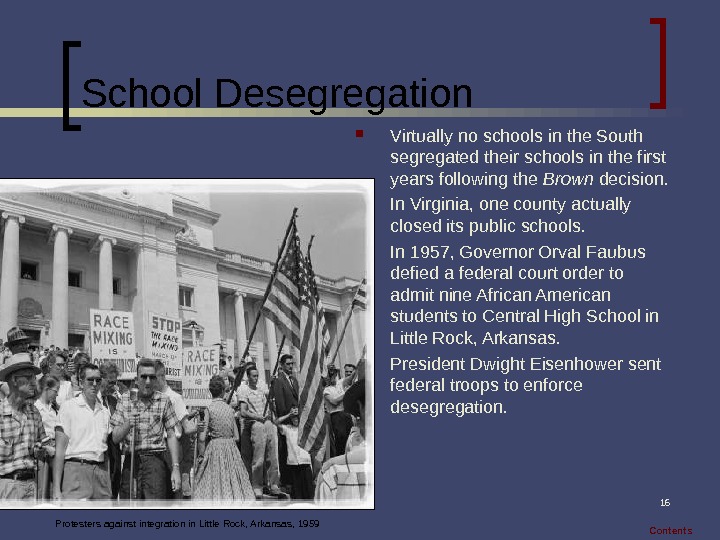

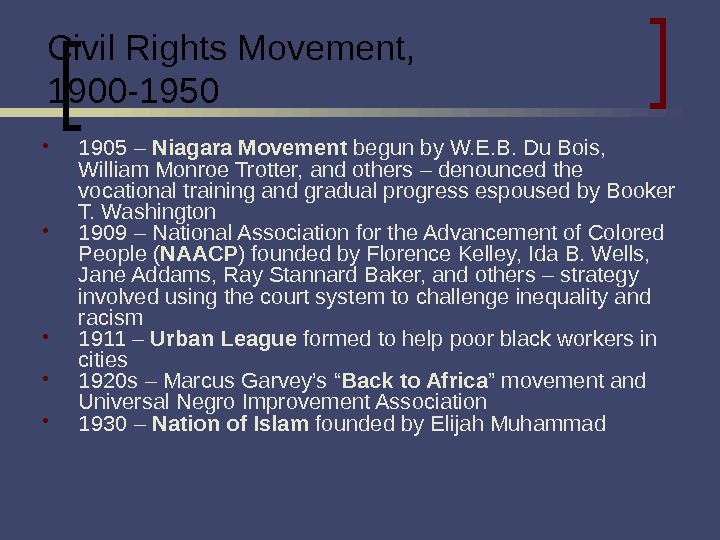
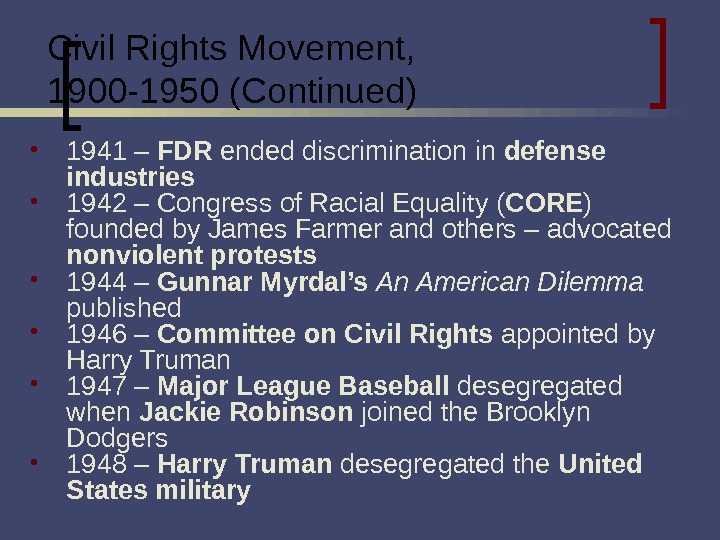
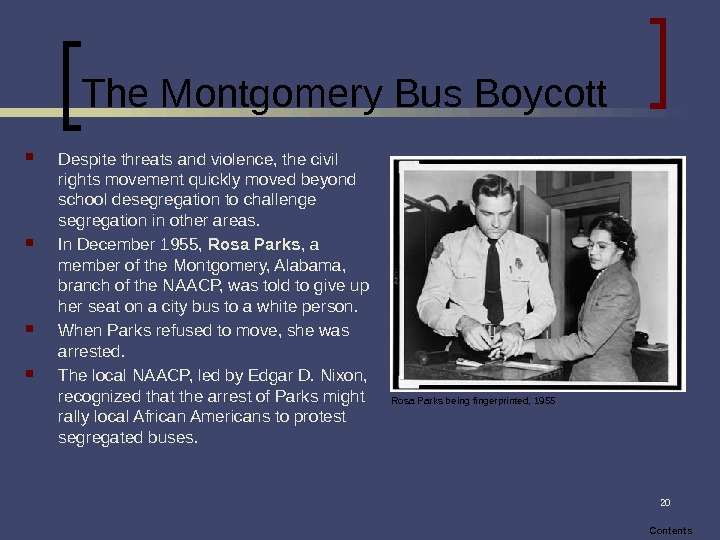
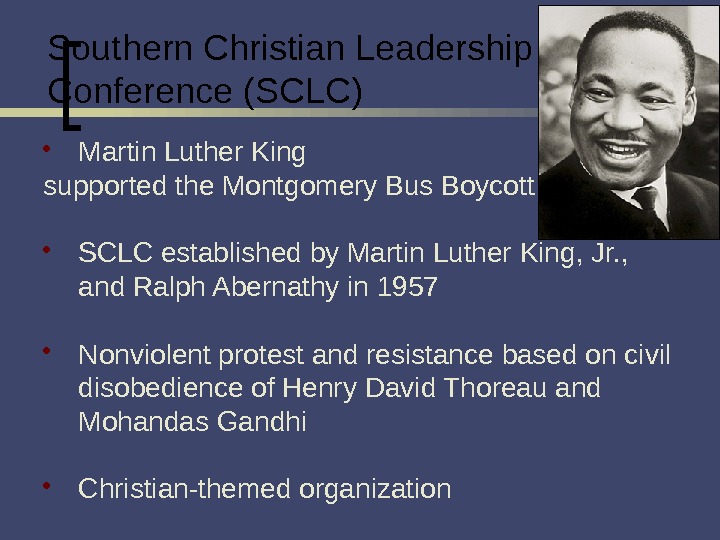
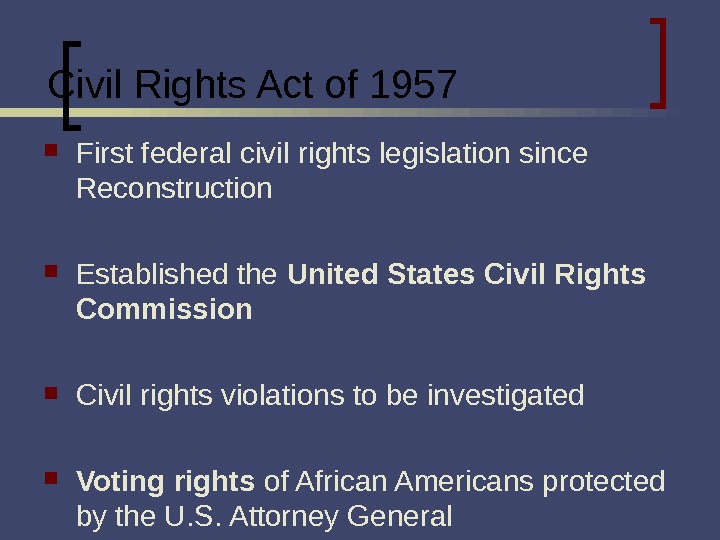
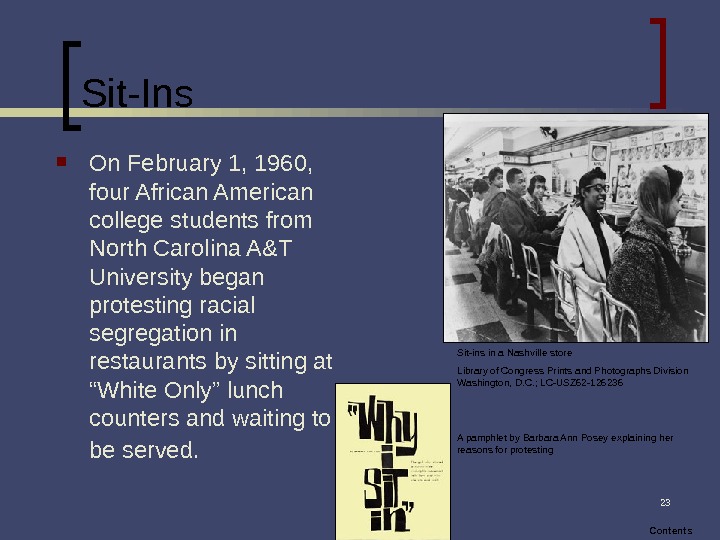
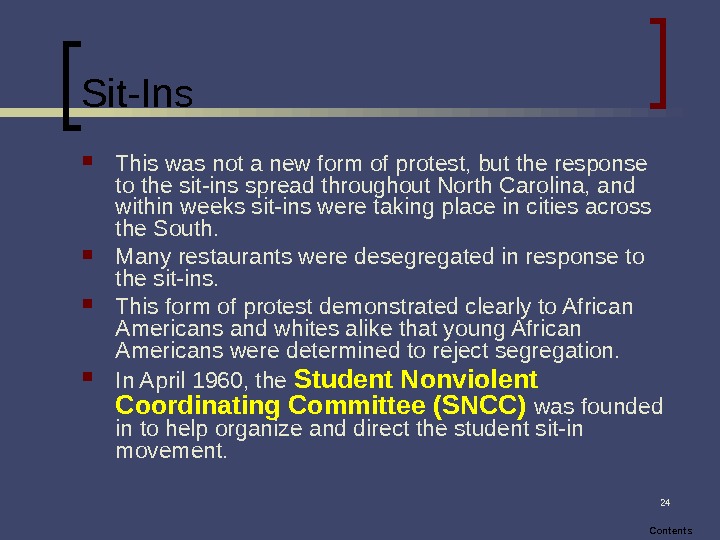
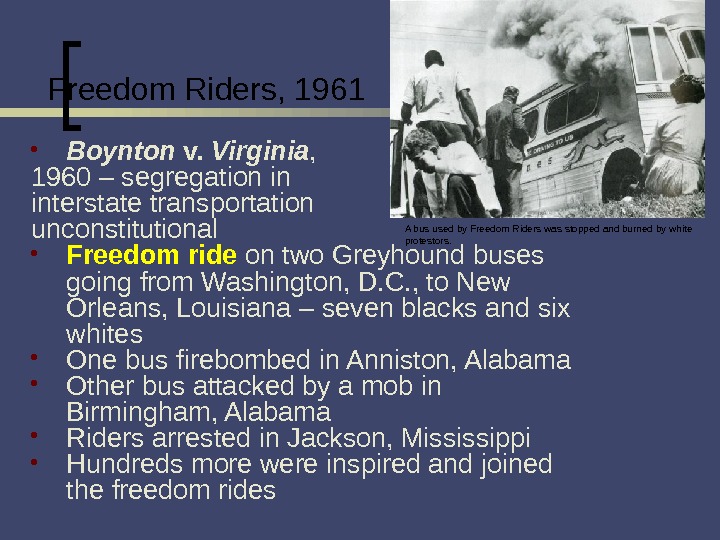
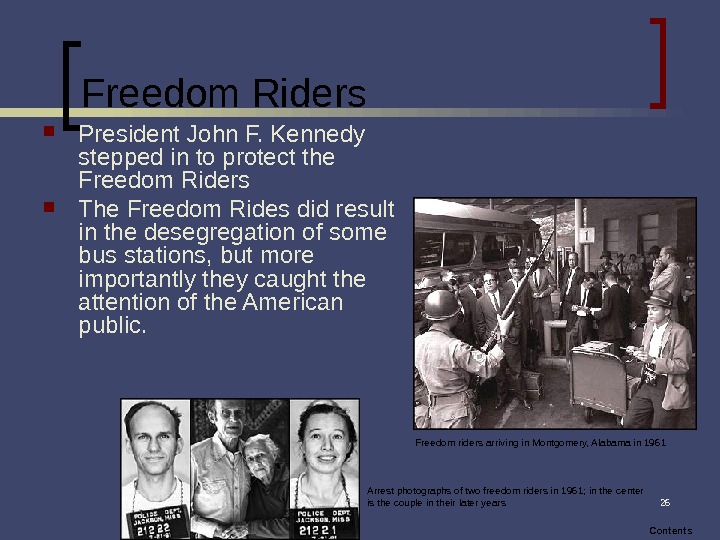
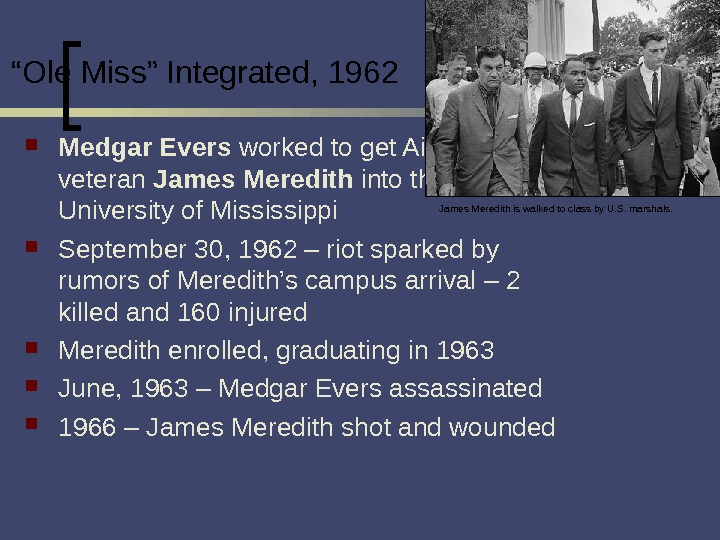
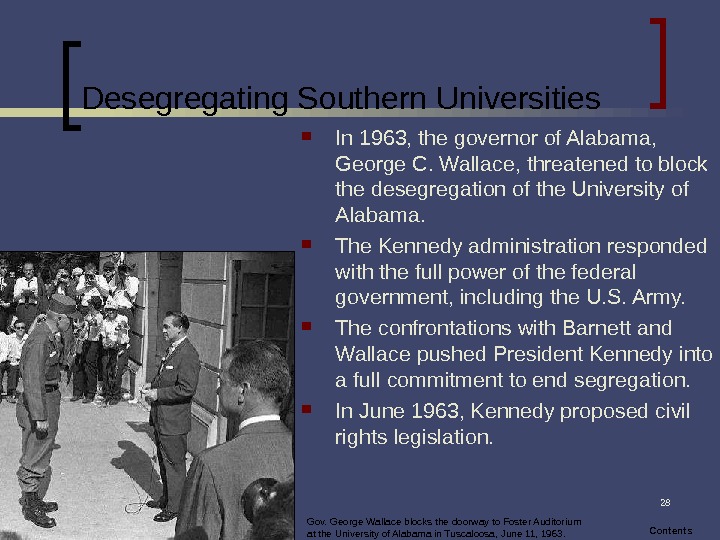

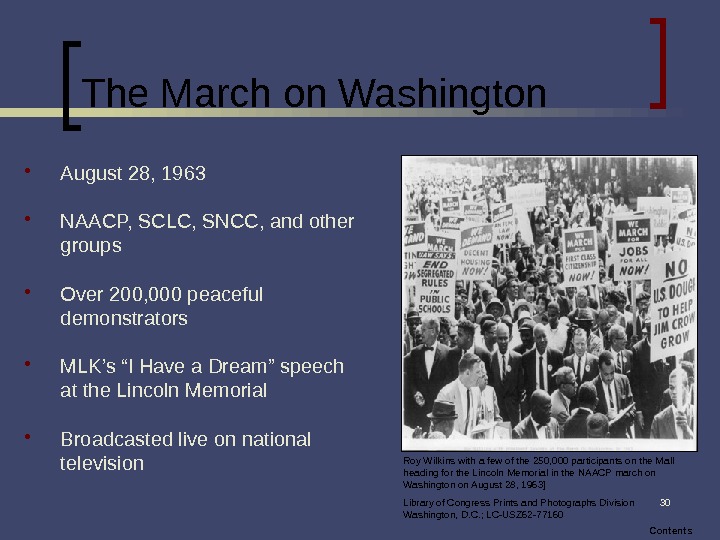
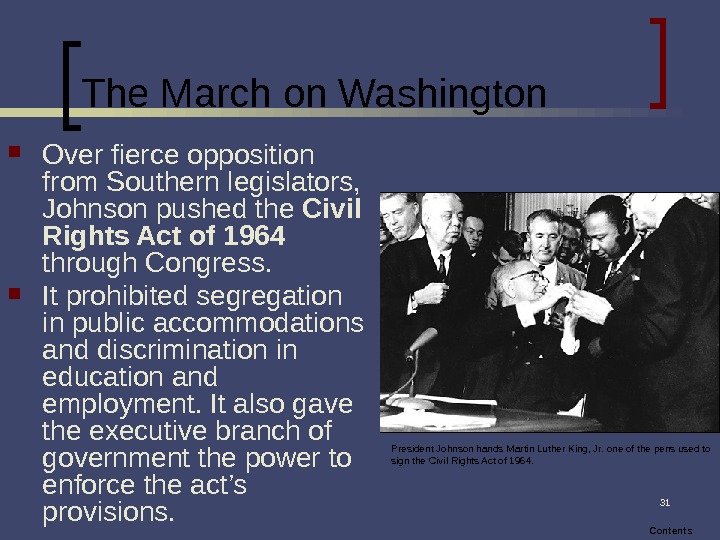
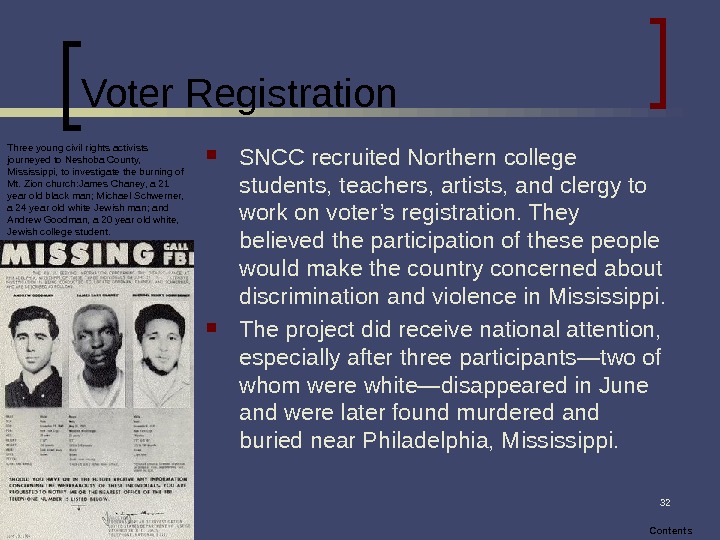
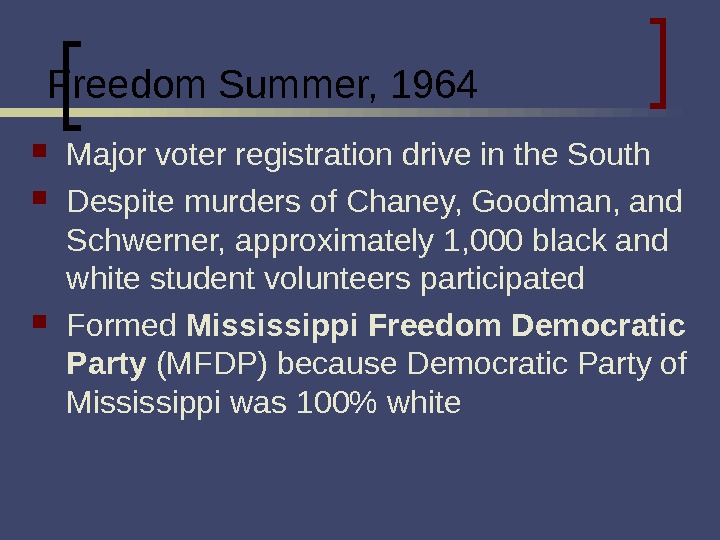
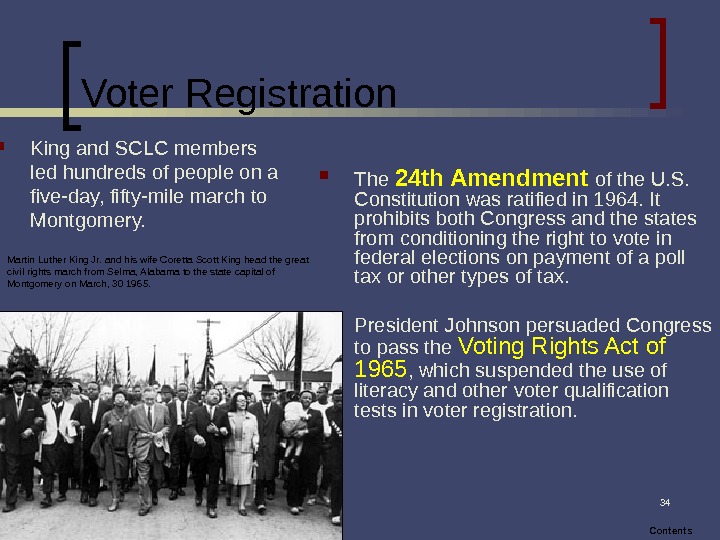

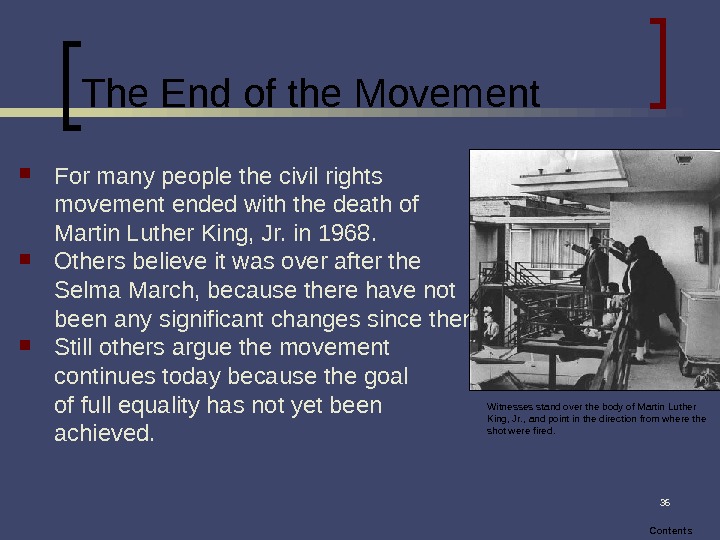
- Размер: 2 Mегабайта
- Количество слайдов: 36
Описание презентации 1 The Civil Rights Movement We have talked по слайдам
 1 The Civil Rights Movement We have talked long enough in this country about equal rights. We have talked for one hundred years or more. It is time now to write it in the books of law. ~ President Lyndon Johnson I refuse to accept the view that mankind is so tragically bound to the starless midnight of racism and war that the bright daybreak of peace and brotherhood can never become a reality. . . I believe that unarmed truth and unconditional love will have the final word. ~ Reverend Martin Luther King, Jr.
1 The Civil Rights Movement We have talked long enough in this country about equal rights. We have talked for one hundred years or more. It is time now to write it in the books of law. ~ President Lyndon Johnson I refuse to accept the view that mankind is so tragically bound to the starless midnight of racism and war that the bright daybreak of peace and brotherhood can never become a reality. . . I believe that unarmed truth and unconditional love will have the final word. ~ Reverend Martin Luther King, Jr.
 2 The Civil Rights Movement: Contents Key Concept Harlem Renaissance Segregation School Desegregation The Montgomery Bus Boycott Sit-Ins Freedom Riders Desegregating Southern Universities The March on Washington Voter Registration The End of the Movement. Click on “Contents” on other pages to return to this page.
2 The Civil Rights Movement: Contents Key Concept Harlem Renaissance Segregation School Desegregation The Montgomery Bus Boycott Sit-Ins Freedom Riders Desegregating Southern Universities The March on Washington Voter Registration The End of the Movement. Click on “Contents” on other pages to return to this page.
 3 Key Concept: Discuss how the civil rights movement evolved during the 1950 s and 1960 s and explain each of the three developments. Civil Rights for African Americans. Development: Warren Court Brown v. Board of Education Civil Rights Act of 1964 Voting Rights Act of 196524 th Amendment Development: Johnson Presidency. Development: Protests. Montgomery Bus Boycott sit-ins. For African Americans, the path from slavery to full civil rights was long and difficult. Several developments during the 1950 s and 1960 s legally guaranteed them full citizenship: Contents
3 Key Concept: Discuss how the civil rights movement evolved during the 1950 s and 1960 s and explain each of the three developments. Civil Rights for African Americans. Development: Warren Court Brown v. Board of Education Civil Rights Act of 1964 Voting Rights Act of 196524 th Amendment Development: Johnson Presidency. Development: Protests. Montgomery Bus Boycott sit-ins. For African Americans, the path from slavery to full civil rights was long and difficult. Several developments during the 1950 s and 1960 s legally guaranteed them full citizenship: Contents
 4 Harlem Renaissance The Harlem Renaissance was an African American cultural movement of the 1920 s and early 1930 s centered around the Harlem neighborhood of New York City. Several factors laid the groundwork for the movement. During a phenomenon known as the Great Migration , hundreds of thousands of African Americans moved from the economically depressed rural South to the industrial cities of the North, taking advantage of employment opportunities created by World War I. [Grocery store, Harlem, 1940] Library of Congress Prints and Photographs Division Washington, D. C. ; LC-USZC 4 -4737 Contents
4 Harlem Renaissance The Harlem Renaissance was an African American cultural movement of the 1920 s and early 1930 s centered around the Harlem neighborhood of New York City. Several factors laid the groundwork for the movement. During a phenomenon known as the Great Migration , hundreds of thousands of African Americans moved from the economically depressed rural South to the industrial cities of the North, taking advantage of employment opportunities created by World War I. [Grocery store, Harlem, 1940] Library of Congress Prints and Photographs Division Washington, D. C. ; LC-USZC 4 -4737 Contents
 5 Harlem Renaissance Jazz and blues music moved with the African American populations from the South and Midwest into the bars and cabarets of Harlem. Diversity and experimentation also flourished in the performing arts and were reflected in blues by such people as Bessie Smith and in jazz by such people as Duke Ellington and Fats Waller. Bessie Smith Duke Ellington Fats Waller Contents
5 Harlem Renaissance Jazz and blues music moved with the African American populations from the South and Midwest into the bars and cabarets of Harlem. Diversity and experimentation also flourished in the performing arts and were reflected in blues by such people as Bessie Smith and in jazz by such people as Duke Ellington and Fats Waller. Bessie Smith Duke Ellington Fats Waller Contents
 6 Segregation was an attempt by many white Southerners to separate the races in every aspect of daily life. Segregation was often called the Jim Crow system, after a minstrel show character from the 1830 s who was an African American slave who embodied negative stereotypes of African Americans. Contents. Drinking fountain on county courthouse lawn, Halifax, North Carolina; Library of Congress, Prints & Photographs Division, FSA/OWI Collection, [reproduction number, e. g. , LC-USF 34 -9058 -C]
6 Segregation was an attempt by many white Southerners to separate the races in every aspect of daily life. Segregation was often called the Jim Crow system, after a minstrel show character from the 1830 s who was an African American slave who embodied negative stereotypes of African Americans. Contents. Drinking fountain on county courthouse lawn, Halifax, North Carolina; Library of Congress, Prints & Photographs Division, FSA/OWI Collection, [reproduction number, e. g. , LC-USF 34 -9058 -C]
 7 Segregation African Americans had separate schools, transportation, restaurants, and parks, many of which were poorly funded and inferior to those of whites. Over the next 75 years, Jim Crow signs to separate the races went up in every possible place. Entrance of movie house for African Americans on Saturday afternoon, Belzoni, Mississippi Delta, Mississippi Library of Congress, Prints & Photographs Division, FSA/OWI Collection, [reproduction number, e. g. , LC-USF 34 -9058 -C] Contents
7 Segregation African Americans had separate schools, transportation, restaurants, and parks, many of which were poorly funded and inferior to those of whites. Over the next 75 years, Jim Crow signs to separate the races went up in every possible place. Entrance of movie house for African Americans on Saturday afternoon, Belzoni, Mississippi Delta, Mississippi Library of Congress, Prints & Photographs Division, FSA/OWI Collection, [reproduction number, e. g. , LC-USF 34 -9058 -C] Contents
 8 Segregation The system of segregation also included the denial of voting rights, known as disenfranchisement. Between 1890 and 1910, all Southern states passed laws imposing requirements for voting. These were used to prevent African Americans from voting, in spite of the 15 th Amendment , which had been designed to protect African American voting rights. Contents
8 Segregation The system of segregation also included the denial of voting rights, known as disenfranchisement. Between 1890 and 1910, all Southern states passed laws imposing requirements for voting. These were used to prevent African Americans from voting, in spite of the 15 th Amendment , which had been designed to protect African American voting rights. Contents
 9 Segregation The voting requirements included the ability to read and write, which disqualified many African Americans who had not had access to education; property ownership, which excluded most African Americans, and paying a poll tax, which prevented most Southern African Americans from voting because they could not afford it. Contents. Left: A political cartoon about poll taxes by Theodore Geisel (Dr. Seuss) Bottom: A poll tax receipt from Birmingham, Alabama in
9 Segregation The voting requirements included the ability to read and write, which disqualified many African Americans who had not had access to education; property ownership, which excluded most African Americans, and paying a poll tax, which prevented most Southern African Americans from voting because they could not afford it. Contents. Left: A political cartoon about poll taxes by Theodore Geisel (Dr. Seuss) Bottom: A poll tax receipt from Birmingham, Alabama in
 10 Segregation Conditions for African Americans in the Northern states were somewhat better, though up to 1910 only ten percent of African Americans lived in the North. Segregated facilities were not as common in the North, but African Americans were usually denied entrance to the best hotels and restaurants. African Americans were usually free to vote in the North. Actor Charlton Heston protests a whites-only restaurant A grammatically incorrect segregation sign Contents
10 Segregation Conditions for African Americans in the Northern states were somewhat better, though up to 1910 only ten percent of African Americans lived in the North. Segregated facilities were not as common in the North, but African Americans were usually denied entrance to the best hotels and restaurants. African Americans were usually free to vote in the North. Actor Charlton Heston protests a whites-only restaurant A grammatically incorrect segregation sign Contents
 11 Segregation In the late 1800 s, African Americans sued to stop separate seating in railroad cars, states’ disfranchisement of voters, and denial of access to schools and restaurants. One of the cases against segregated rail travel was Plessy v. Ferguson (1896), in which the Supreme Court of the United States ruled that “separate but equal” accommodations were constitutional. In order to protest segregation, African Americans created national organizations. The National Afro-American League was formed in 1890; W. E. B. Du Bois helped create the Niagara Movement in 1905 and the National Association for the Advancement of Colored People (NAACP) in 1909. Contents. A Sign at the Greyhound Bus Station, Rome, Georgia Esther Bubley, photographer, September 1943.
11 Segregation In the late 1800 s, African Americans sued to stop separate seating in railroad cars, states’ disfranchisement of voters, and denial of access to schools and restaurants. One of the cases against segregated rail travel was Plessy v. Ferguson (1896), in which the Supreme Court of the United States ruled that “separate but equal” accommodations were constitutional. In order to protest segregation, African Americans created national organizations. The National Afro-American League was formed in 1890; W. E. B. Du Bois helped create the Niagara Movement in 1905 and the National Association for the Advancement of Colored People (NAACP) in 1909. Contents. A Sign at the Greyhound Bus Station, Rome, Georgia Esther Bubley, photographer, September 1943.
 12 Segregation The NAACP became one of the most important African American organizations of the twentieth century. It relied mainly on legal strategies that challenged segregation and discrimination in the courts. Interestingly, Barak Obama became president 100 years after the founding of the NAACP. 20 th Annual session of the N. A. A. C. P. , 6/26/29 Cleveland, Ohio Library of Congress Prints and Photographs Division Washington, D. C. ; LC-USZ 62 -111535 Contents
12 Segregation The NAACP became one of the most important African American organizations of the twentieth century. It relied mainly on legal strategies that challenged segregation and discrimination in the courts. Interestingly, Barak Obama became president 100 years after the founding of the NAACP. 20 th Annual session of the N. A. A. C. P. , 6/26/29 Cleveland, Ohio Library of Congress Prints and Photographs Division Washington, D. C. ; LC-USZ 62 -111535 Contents
 13 School Desegregation After World War II, the NAACP’s campaign for civil rights continued to proceed. Led by Thurgood Marshall, the NAACP Legal Defense Fund challenged and overturned many forms of discrimination. Supreme Court Justice Thurgood Marshall Contents
13 School Desegregation After World War II, the NAACP’s campaign for civil rights continued to proceed. Led by Thurgood Marshall, the NAACP Legal Defense Fund challenged and overturned many forms of discrimination. Supreme Court Justice Thurgood Marshall Contents
 14 School Desegregation The main focus of the NAACP turned to equal educational opportunities. Marshall and the Defense Fund worked with Southern plaintiffs to challenge the Plessy decision, arguing that separate was inherently unequal. The Supreme Court of the United States heard arguments on five cases that challenged elementary and secondary school segregation. Contents
14 School Desegregation The main focus of the NAACP turned to equal educational opportunities. Marshall and the Defense Fund worked with Southern plaintiffs to challenge the Plessy decision, arguing that separate was inherently unequal. The Supreme Court of the United States heard arguments on five cases that challenged elementary and secondary school segregation. Contents
 15 School Desegregation In May 1954, the Warren Court issued its landmark ruling in Brown v. Board of Education of Topeka, stating racially segregated education was unconstitutional and overturning the Plessy decision. White Southerners were shocked by the Brown decision. Desegregate the schools! Vote Socialist Workers : Peter Camejo for president, Willie Mae Reid for vice-president. Library of Congress Prints and Photographs Division Washington, D. C. ; LC-USZ 62 -101452 Contents
15 School Desegregation In May 1954, the Warren Court issued its landmark ruling in Brown v. Board of Education of Topeka, stating racially segregated education was unconstitutional and overturning the Plessy decision. White Southerners were shocked by the Brown decision. Desegregate the schools! Vote Socialist Workers : Peter Camejo for president, Willie Mae Reid for vice-president. Library of Congress Prints and Photographs Division Washington, D. C. ; LC-USZ 62 -101452 Contents
 16 School Desegregation Virtually no schools in the South segregated their schools in the first years following the Brown decision. In Virginia, one county actually closed its public schools. In 1957, Governor Orval Faubus defied a federal court order to admit nine African American students to Central High School in Little Rock, Arkansas. President Dwight Eisenhower sent federal troops to enforce desegregation. Protesters against integration in Little Rock, Arkansas, 1959 Contents
16 School Desegregation Virtually no schools in the South segregated their schools in the first years following the Brown decision. In Virginia, one county actually closed its public schools. In 1957, Governor Orval Faubus defied a federal court order to admit nine African American students to Central High School in Little Rock, Arkansas. President Dwight Eisenhower sent federal troops to enforce desegregation. Protesters against integration in Little Rock, Arkansas, 1959 Contents
 17 School Desegregation As desegregation continued, the membership of the Ku Klux Klan (KKK) grew. The KKK used violence or threats against anyone who was suspected of favoring desegregation or African American civil rights. Ku Klux Klan terror, including intimidation and murder, was widespread in the South during the 1950 s and 1960 s, though Klan activities were not always reported in the media. Contents
17 School Desegregation As desegregation continued, the membership of the Ku Klux Klan (KKK) grew. The KKK used violence or threats against anyone who was suspected of favoring desegregation or African American civil rights. Ku Klux Klan terror, including intimidation and murder, was widespread in the South during the 1950 s and 1960 s, though Klan activities were not always reported in the media. Contents
 Civil Rights Movement, 1900 -1950 1905 – Niagara Movement begun by W. E. B. Du Bois, William Monroe Trotter, and others – denounced the vocational training and gradual progress espoused by Booker T. Washington 1909 – National Association for the Advancement of Colored People ( NAACP ) founded by Florence Kelley, Ida B. Wells, Jane Addams, Ray Stannard Baker, and others – strategy involved using the court system to challenge inequality and racism 1911 – Urban League formed to help poor black workers in cities 1920 s – Marcus Garvey’s “ Back to Africa ” movement and Universal Negro Improvement Association 1930 – Nation of Islam founded by Elijah Muhammad
Civil Rights Movement, 1900 -1950 1905 – Niagara Movement begun by W. E. B. Du Bois, William Monroe Trotter, and others – denounced the vocational training and gradual progress espoused by Booker T. Washington 1909 – National Association for the Advancement of Colored People ( NAACP ) founded by Florence Kelley, Ida B. Wells, Jane Addams, Ray Stannard Baker, and others – strategy involved using the court system to challenge inequality and racism 1911 – Urban League formed to help poor black workers in cities 1920 s – Marcus Garvey’s “ Back to Africa ” movement and Universal Negro Improvement Association 1930 – Nation of Islam founded by Elijah Muhammad
 Civil Rights Movement, 1900 -1950 (Continued) 1941 – FDR ended discrimination in defense industries 1942 – Congress of Racial Equality ( CORE ) founded by James Farmer and others – advocated nonviolent protests 1944 – Gunnar Myrdal’s An American Dilemma published 1946 – Committee on Civil Rights appointed by Harry Truman 1947 – Major League Baseball desegregated when Jackie Robinson joined the Brooklyn Dodgers 1948 – Harry Truman desegregated the United States military
Civil Rights Movement, 1900 -1950 (Continued) 1941 – FDR ended discrimination in defense industries 1942 – Congress of Racial Equality ( CORE ) founded by James Farmer and others – advocated nonviolent protests 1944 – Gunnar Myrdal’s An American Dilemma published 1946 – Committee on Civil Rights appointed by Harry Truman 1947 – Major League Baseball desegregated when Jackie Robinson joined the Brooklyn Dodgers 1948 – Harry Truman desegregated the United States military
 20 The Montgomery Bus Boycott Despite threats and violence, the civil rights movement quickly moved beyond school desegregation to challenge segregation in other areas. In December 1955, Rosa Parks , a member of the Montgomery, Alabama, branch of the NAACP, was told to give up her seat on a city bus to a white person. When Parks refused to move, she was arrested. The local NAACP, led by Edgar D. Nixon, recognized that the arrest of Parks might rally local African Americans to protest segregated buses. Rosa Parks being fingerprinted, 1955 Contents
20 The Montgomery Bus Boycott Despite threats and violence, the civil rights movement quickly moved beyond school desegregation to challenge segregation in other areas. In December 1955, Rosa Parks , a member of the Montgomery, Alabama, branch of the NAACP, was told to give up her seat on a city bus to a white person. When Parks refused to move, she was arrested. The local NAACP, led by Edgar D. Nixon, recognized that the arrest of Parks might rally local African Americans to protest segregated buses. Rosa Parks being fingerprinted, 1955 Contents
 Southern Christian Leadership Conference (SCLC) Martin Luther King supported the Montgomery Bus Boycott SCLC established by Martin Luther King, Jr. , and Ralph Abernathy in 1957 Nonviolent protest and resistance based on civil disobedience of Henry David Thoreau and Mohandas Gandhi Christian-themed organization
Southern Christian Leadership Conference (SCLC) Martin Luther King supported the Montgomery Bus Boycott SCLC established by Martin Luther King, Jr. , and Ralph Abernathy in 1957 Nonviolent protest and resistance based on civil disobedience of Henry David Thoreau and Mohandas Gandhi Christian-themed organization
 Civil Rights Act of 1957 First federal civil rights legislation since Reconstruction Established the United States Civil Rights Commission Civil rights violations to be investigated Voting rights of African Americans protected by the U. S. Attorney General
Civil Rights Act of 1957 First federal civil rights legislation since Reconstruction Established the United States Civil Rights Commission Civil rights violations to be investigated Voting rights of African Americans protected by the U. S. Attorney General
 23 Sit-Ins On February 1, 1960, four African American college students from North Carolina A&T University began protesting racial segregation in restaurants by sitting at “White Only” lunch counters and waiting to be served. Contents. Sit-ins in a Nashville store Library of Congress Prints and Photographs Division Washington, D. C. ; LC-USZ 62 -126236 A pamphlet by Barbara Ann Posey explaining her reasons for protesting
23 Sit-Ins On February 1, 1960, four African American college students from North Carolina A&T University began protesting racial segregation in restaurants by sitting at “White Only” lunch counters and waiting to be served. Contents. Sit-ins in a Nashville store Library of Congress Prints and Photographs Division Washington, D. C. ; LC-USZ 62 -126236 A pamphlet by Barbara Ann Posey explaining her reasons for protesting
 24 Sit-Ins This was not a new form of protest, but the response to the sit-ins spread throughout North Carolina, and within weeks sit-ins were taking place in cities across the South. Many restaurants were desegregated in response to the sit-ins. This form of protest demonstrated clearly to African Americans and whites alike that young African Americans were determined to reject segregation. In April 1960, the Student Nonviolent Coordinating Committee (SNCC) was founded in to help organize and direct the student sit-in movement. Contents
24 Sit-Ins This was not a new form of protest, but the response to the sit-ins spread throughout North Carolina, and within weeks sit-ins were taking place in cities across the South. Many restaurants were desegregated in response to the sit-ins. This form of protest demonstrated clearly to African Americans and whites alike that young African Americans were determined to reject segregation. In April 1960, the Student Nonviolent Coordinating Committee (SNCC) was founded in to help organize and direct the student sit-in movement. Contents
 Freedom Riders, 1961 Boynton v. Virginia , 1960 – segregation in interstate transportation unconstitutional Freedom ride on two Greyhound buses going from Washington, D. C. , to New Orleans, Louisiana – seven blacks and six whites One bus firebombed in Anniston, Alabama Other bus attacked by a mob in Birmingham, Alabama Riders arrested in Jackson, Mississippi Hundreds more were inspired and joined the freedom rides A bus used by Freedom Riders was stopped and burned by white protestors.
Freedom Riders, 1961 Boynton v. Virginia , 1960 – segregation in interstate transportation unconstitutional Freedom ride on two Greyhound buses going from Washington, D. C. , to New Orleans, Louisiana – seven blacks and six whites One bus firebombed in Anniston, Alabama Other bus attacked by a mob in Birmingham, Alabama Riders arrested in Jackson, Mississippi Hundreds more were inspired and joined the freedom rides A bus used by Freedom Riders was stopped and burned by white protestors.
 26 Freedom Riders President John F. Kennedy stepped in to protect the Freedom Riders The Freedom Rides did result in the desegregation of some bus stations, but more importantly they caught the attention of the American public. Contents. Arrest photographs of two freedom riders in 1961; in the center is the couple in their later years Freedom riders arriving in Montgomery, Alabama in
26 Freedom Riders President John F. Kennedy stepped in to protect the Freedom Riders The Freedom Rides did result in the desegregation of some bus stations, but more importantly they caught the attention of the American public. Contents. Arrest photographs of two freedom riders in 1961; in the center is the couple in their later years Freedom riders arriving in Montgomery, Alabama in
 “ Ole Miss” Integrated, 1962 Medgar Evers worked to get Air Force veteran James Meredith into the all-white University of Mississippi September 30, 1962 – riot sparked by rumors of Meredith’s campus arrival – 2 killed and 160 injured Meredith enrolled, graduating in 1963 June, 1963 – Medgar Evers assassinated 1966 – James Meredith shot and wounded James Meredith is walked to class by U. S. marshals.
“ Ole Miss” Integrated, 1962 Medgar Evers worked to get Air Force veteran James Meredith into the all-white University of Mississippi September 30, 1962 – riot sparked by rumors of Meredith’s campus arrival – 2 killed and 160 injured Meredith enrolled, graduating in 1963 June, 1963 – Medgar Evers assassinated 1966 – James Meredith shot and wounded James Meredith is walked to class by U. S. marshals.
 28 Desegregating Southern Universities In 1963, the governor of Alabama, George C. Wallace, threatened to block the desegregation of the University of Alabama. The Kennedy administration responded with the full power of the federal government, including the U. S. Army. The confrontations with Barnett and Wallace pushed President Kennedy into a full commitment to end segregation. In June 1963, Kennedy proposed civil rights legislation. Gov. George Wallace blocks the doorway to Foster Auditorium at the University of Alabama in Tuscaloosa, June 11, 1963. Contents
28 Desegregating Southern Universities In 1963, the governor of Alabama, George C. Wallace, threatened to block the desegregation of the University of Alabama. The Kennedy administration responded with the full power of the federal government, including the U. S. Army. The confrontations with Barnett and Wallace pushed President Kennedy into a full commitment to end segregation. In June 1963, Kennedy proposed civil rights legislation. Gov. George Wallace blocks the doorway to Foster Auditorium at the University of Alabama in Tuscaloosa, June 11, 1963. Contents
 Kennedy’s Television Address, 1963 June 11, 1963 John F. Kennedy spoke on national television Civil rights were a “moral issue” Pledged “equal rights and equal opportunities” Proposed new civil rights legislation Aided by Attorney General Robert “Bobby” Kennedy (his brother)
Kennedy’s Television Address, 1963 June 11, 1963 John F. Kennedy spoke on national television Civil rights were a “moral issue” Pledged “equal rights and equal opportunities” Proposed new civil rights legislation Aided by Attorney General Robert “Bobby” Kennedy (his brother)
 30 The March on Washington August 28, 1963 NAACP, SCLC, SNCC, and other groups Over 200, 000 peaceful demonstrators MLK’s “I Have a Dream” speech at the Lincoln Memorial Broadcasted live on national television Roy Wilkins with a few of the 250, 000 participants on the Mall heading for the Lincoln Memorial in the NAACP march on Washington on August 28, 1963] Library of Congress Prints and Photographs Division Washington, D. C. ; LC-USZ 62 -77160 Contents
30 The March on Washington August 28, 1963 NAACP, SCLC, SNCC, and other groups Over 200, 000 peaceful demonstrators MLK’s “I Have a Dream” speech at the Lincoln Memorial Broadcasted live on national television Roy Wilkins with a few of the 250, 000 participants on the Mall heading for the Lincoln Memorial in the NAACP march on Washington on August 28, 1963] Library of Congress Prints and Photographs Division Washington, D. C. ; LC-USZ 62 -77160 Contents
 31 The March on Washington Over fierce opposition from Southern legislators, Johnson pushed the Civil Rights Act of 1964 through Congress. It prohibited segregation in public accommodations and discrimination in education and employment. It also gave the executive branch of government the power to enforce the act’s provisions. President Johnson hands Martin Luther King, Jr. one of the pens used to sign the Civil Rights Act of 1964. Contents
31 The March on Washington Over fierce opposition from Southern legislators, Johnson pushed the Civil Rights Act of 1964 through Congress. It prohibited segregation in public accommodations and discrimination in education and employment. It also gave the executive branch of government the power to enforce the act’s provisions. President Johnson hands Martin Luther King, Jr. one of the pens used to sign the Civil Rights Act of 1964. Contents
 32 Voter Registration SNCC recruited Northern college students, teachers, artists, and clergy to work on voter’s registration. They believed the participation of these people would make the country concerned about discrimination and violence in Mississippi. The project did receive national attention, especially after three participants—two of whom were white—disappeared in June and were later found murdered and buried near Philadelphia, Mississippi. Three young civil rights activists journeyed to Neshoba County, Mississippi, to investigate the burning of Mt. Zion church: James Chaney, a 21 year old black man; Michael Schwerner, a 24 year old white Jewish man; and Andrew Goodman, a 20 year old white, Jewish college student. Contents
32 Voter Registration SNCC recruited Northern college students, teachers, artists, and clergy to work on voter’s registration. They believed the participation of these people would make the country concerned about discrimination and violence in Mississippi. The project did receive national attention, especially after three participants—two of whom were white—disappeared in June and were later found murdered and buried near Philadelphia, Mississippi. Three young civil rights activists journeyed to Neshoba County, Mississippi, to investigate the burning of Mt. Zion church: James Chaney, a 21 year old black man; Michael Schwerner, a 24 year old white Jewish man; and Andrew Goodman, a 20 year old white, Jewish college student. Contents
 Freedom Summer, 1964 Major voter registration drive in the South Despite murders of Chaney, Goodman, and Schwerner, approximately 1, 000 black and white student volunteers participated Formed Mississippi Freedom Democratic Party (MFDP) because Democratic Party of Mississippi was 100% white
Freedom Summer, 1964 Major voter registration drive in the South Despite murders of Chaney, Goodman, and Schwerner, approximately 1, 000 black and white student volunteers participated Formed Mississippi Freedom Democratic Party (MFDP) because Democratic Party of Mississippi was 100% white
 34 Voter Registration The 24 th Amendment of the U. S. Constitution was ratified in 1964. It prohibits both Congress and the states from conditioning the right to vote in federal elections on payment of a poll tax or other types of tax. President Johnson persuaded Congress to pass the Voting Rights Act of 1965 , which suspended the use of literacy and other voter qualification tests in voter registration. Martin Luther King Jr. and his wife Coretta Scott King head the great civil rights march from Selma, Alabama to the state capital of Montgomery on March, 30 1965. King and SCLC members led hundreds of people on a five-day, fifty-mile march to Montgomery. Contents
34 Voter Registration The 24 th Amendment of the U. S. Constitution was ratified in 1964. It prohibits both Congress and the states from conditioning the right to vote in federal elections on payment of a poll tax or other types of tax. President Johnson persuaded Congress to pass the Voting Rights Act of 1965 , which suspended the use of literacy and other voter qualification tests in voter registration. Martin Luther King Jr. and his wife Coretta Scott King head the great civil rights march from Selma, Alabama to the state capital of Montgomery on March, 30 1965. King and SCLC members led hundreds of people on a five-day, fifty-mile march to Montgomery. Contents
 35 Voter Registration Over the next three years, almost one million more African Americans in the South registered to vote. By 1968, African American voters had having a significant impact on Southern politics. During the 1970 s, African Americans were seeking and winning public offices in majority African American electoral districts. Contents
35 Voter Registration Over the next three years, almost one million more African Americans in the South registered to vote. By 1968, African American voters had having a significant impact on Southern politics. During the 1970 s, African Americans were seeking and winning public offices in majority African American electoral districts. Contents
 36 The End of the Movement For many people the civil rights movement ended with the death of Martin Luther King, Jr. in 1968. Others believe it was over after the Selma March, because there have not been any significant changes since then. Still others argue the movement continues today because the goal of full equality has not yet been achieved. Contents. Witnesses stand over the body of Martin Luther King, Jr. , and point in the direction from where the shot were fired.
36 The End of the Movement For many people the civil rights movement ended with the death of Martin Luther King, Jr. in 1968. Others believe it was over after the Selma March, because there have not been any significant changes since then. Still others argue the movement continues today because the goal of full equality has not yet been achieved. Contents. Witnesses stand over the body of Martin Luther King, Jr. , and point in the direction from where the shot were fired.

